Synergistic Reaction of SO2 with NO2 in Presence of H2O and NH3: A Potential Source of Sulfate Aerosol
Abstract
:1. Introduction
2. Results and Discussion
2.1. The Reaction of SO2-2NO2-nH2O (n = 0, 1, 2, 3)
2.1.1. The Reaction of SO2-2NO2
2.1.2. The Reaction of SO2-2NO2-H2O
2.1.3. The Reaction of SO2-2NO2-2H2O
2.1.4. The Reaction of SO2-2NO2-3H2O
2.2. The Reaction of SO2-2NO2-nH2O-mNH3 (n = 0, 1, 2; m = 1, 2)
2.2.1. The Reaction of SO2-2NO2-NH3
2.2.2. The Reaction of SO2-2NO2-H2O-NH3
2.2.3. The Reaction of SO2-2NO2-2H2O-NH3
2.2.4. The Reaction of SO2-2NO2-H2O-2NH3
3. Materials and Methods
4. Conclusions
Supplementary Materials
Author Contributions
Funding
Conflicts of Interest
Abbreviations
| PM | Particulate Matter |
| DFT | Density Functional Theory |
| RC | Reactant complex |
| IM | Intermediate |
| PC | Product |
| TS | Transient state |
| IRC | Intrinsic reaction coordinate |
| ESP | Electrostatic potential |
References
- You, C.F.; Xu, X.C. Coal combustion and its pollution control in China. Energy 2010, 35, 4467–4472. [Google Scholar] [CrossRef]
- Hewitt, C.N. The atmospheric chemistry of sulphur and nitrogen in power station plumes. Atmos. Environ. 2001, 35, 1155–1170. [Google Scholar] [CrossRef]
- Rosas, J.M.; Ruiz-Rosas, R.; Rodríguez-Mirasol, J.; Cordero, T. Kinetic study of SO2 removal over lignin-based activated carbon. Chem. Eng. J. 2017, 307, 707–721. [Google Scholar] [CrossRef]
- Baltrusaitis, J.; Jayaweera, P.M.; Grassian, V.H. Sulfur Dioxide Adsorption on TiO2 Nanoparticles: Influence of Particle Size, Coadsorbates, Sample Pretreatment, and Light on Surface Speciation and Surface Coverage. J. Phys. Chem. C 2011, 115, 492–500. [Google Scholar] [CrossRef]
- Kroll, J.A.; Frandsen, B.N.; Kjaergaard, H.G.; Vaida, V. Atmospheric Hydroxyl Radical Source: Reaction of Triplet SO2 and Water. J. Phys. Chem. A 2018, 122, 4465–4469. [Google Scholar] [CrossRef] [PubMed]
- Wang, H.; You, C. Photocatalytic removal of low concentration SO2 by titanium dioxide. Chem. Eng. J. 2016, 292, 199–206. [Google Scholar] [CrossRef]
- Zhang, R.; Wang, G.; Guo, S.; Zamora, M.L.; Ying, Q.; Lin, Y.; Wang, W.; Hu, M.; Wang, Y. Formation of urban fine particulate matter. Chem Rev. 2015, 115, 3803–3855. [Google Scholar] [CrossRef] [PubMed]
- Hung, H.M.; Hoffmann, M.R. Oxidation of Gas-Phase SO2 on the Surfaces of Acidic Microdroplets: Implications for Sulfate and Sulfate Radical Anion Formation in the Atmospheric Liquid Phase. Environ. Sci. Technol. 2015, 49, 13768–13776. [Google Scholar] [CrossRef] [PubMed]
- Long, B.; Bao, J.L.; Truhlar, D.G. Reaction of SO2 with OH in the atmosphere. Phys. Chem. Chem. Phys. Pccp 2017, 19, 8091. [Google Scholar] [CrossRef]
- Sitha, S.; Jewell, L.L.; Piketh, S.J.; Fourie, G. A quantum chemical calculation of the potential energy surface in the formation of HOSO2 from OH + SO2. Atmos. Environ. 2011, 45, 745–754. [Google Scholar] [CrossRef]
- Zhang, R.; Khalizov, A.; Wang, L.; Hu, M.; Xu, W. Nucleation and growth of nanoparticles in the atmosphere. Chem. Rev. 2012, 112, 1957–2011. [Google Scholar] [CrossRef] [PubMed]
- Charlson, R.J.; Schwartz, S.E.; Hales, J.M.; Cess, R.D.; Coakley, J.A.; Hansen, J.E.; Hofmann, D.J. Climate forcing by anthropogenic aerosols. Science 1992, 255, 423–430. [Google Scholar] [CrossRef] [PubMed]
- Zheng, G.J.; Duan, F.K.; Su, H.; Ma, Y.L.; Cheng, Y.; Zheng, B.; Zhang, Q.; Huang, T.; Kimoto, T.; Chang, D.; et al. Exploring the severe winter haze in Beijing: The impact of synoptic weather, regional transport and heterogeneous reactions. Atmos. Chem. Phys. 2015, 15, 2969–2983. [Google Scholar] [CrossRef]
- Wang, Y.; Lampel, J.; Xie, P.; Beirle, S.; Li, A.; Wu, D.; Wagner, T. Ground-based MAX-DOAS observations of tropospheric aerosols, NO2, SO2 and HCHO in Wuxi, China, from 2011 to 2014. Atmos. Chem. Phys. 2017, 17, 2189–2215. [Google Scholar] [CrossRef]
- Quan, J.; Tie, X.; Zhang, Q.; Liu, Q.; Li, X.; Gao, Y.; Zhao, D. Characteristics of heavy aerosol pollution during the 2012–2013 winter in Beijing, China. Atmos. Environ. 2014, 88, 83–89. [Google Scholar] [CrossRef]
- Zhao, X.J.; Zhao, P.S.; Xu, J.; Meng, W.; Pu, W.W.; Dong, F.; He, D.; Shi, Q.F. Analysis of a winter regional haze event and its formation mechanism in the North China Plain. Atmos. Chem. Phys. 2013, 13, 5685–5696. [Google Scholar] [CrossRef] [Green Version]
- Xue, J.; Yuan, Z.; Yu, J.Z.; Lau, A.K.H. An Observation-Based Model for Secondary Inorganic Aerosols. Aerosol Air Qual. Res. 2014, 14, 862–878. [Google Scholar] [CrossRef] [Green Version]
- He, H.; Wang, Y.; Ma, Q.; Ma, J.; Chu, B.; Ji, D.; Tang, G.; Liu, C.; Zhang, H.; Hao, J. Mineral dust and NOx promote the conversion of SO2 to sulfate in heavy pollution days. Sci. Rep. 2014, 4, 4172. [Google Scholar] [CrossRef]
- Cheng, Y.; Zheng, G.; Wei, C.; Mu, Q.; Zheng, B.; Wang, Z.; Gao, M.; Zhang, Q.; He, K.; Carmichael, G.; et al. Reactive nitrogen chemistry in aerosol water as a source of sulfate during haze events in China. Sci. Adv. 2016, 2, e1601530. [Google Scholar] [CrossRef]
- Wang, Y.; Zhang, Q.; Jiang, J.; Zhou, W.; Wang, B.; He, K.; Duan, F.; Zhang, Q.; Philip, S.; Xie, Y. Enhanced sulfate formation during China’s severe winter haze episode in January 2013 missing from current models. J. Geophys. Res. Atmos. 2014, 119, 10425–10440. [Google Scholar] [CrossRef]
- Gao, M.; Carmichael, G.R.; Wang, Y.; Ji, D.; Liu, Z.; Wang, Z. Improving simulations of sulfate aerosols during winter haze over Northern China: The impacts of heterogeneous oxidation by NO2. Front. Environ. Sci. Eng. 2016, 10, 16. [Google Scholar] [CrossRef]
- Xue, J.; Yuan, Z.; Griffith, S.M.; Yu, X.; Lau, A.K.H.; Yu, J.Z. Sulfate Formation Enhanced by a Cocktail of High NOx, SO2, Particulate Matter, and Droplet pH during Haze-Fog Events in Megacities in China: An Observation-Based Modeling Investigation. Environ. Sci. Technol. 2016, 50, 7325–7334. [Google Scholar] [CrossRef] [PubMed]
- Ma, J.; Chu, B.; Liu, J.; Liu, Y.; Zhang, H.; He, H. NOx promotion of SO2 conversion to sulfate: An important mechanism for the occurrence of heavy haze during winter in Beijing. Environ. Pollut. 2018, 233, 662–669. [Google Scholar] [CrossRef] [PubMed]
- Zhang, H.; Chen, S.; Jie, Z.; Zhang, S.; Zhang, Y.; Zhang, X.; Li, Z.; Zeng, X. Formation of aqueous-phase sulfate during the haze period in China: Kinetics and atmospheric implications. Atmos. Environ. 2018, 177, 93–99. [Google Scholar] [CrossRef]
- Wang, G.; Zhang, R.; Gomez, M.E.; Yang, L.; Levy Zamora, M.; Hu, M.; Lin, Y.; Peng, J.; Guo, S.; Meng, J.; et al. Persistent sulfate formation from London Fog to Chinese haze. Proc. Natl. Acad. Sci. United States Am. 2016, 113, 13630–13635. [Google Scholar] [CrossRef] [Green Version]
- Pimentel, A.S.; Lima, F.C.A.; da Silva, A.B.F. The asymmetric dimerization of nitrogen dioxide. Chem. Phys. Lett. 2007, 436, 47–50. [Google Scholar] [CrossRef]
- Miller, Y.; Finlayson-Pitts, B.J.; Gerber, R.B. Ionization of N2O4 in Contact with Water: Mechanism, Time Scales and Atmospheric Implications. J. Am. Chem. Soc. 2009, 131, 12180–12185. [Google Scholar] [CrossRef]
- Liu, C.; Ma, Q.; Liu, Y.; Ma, J.; He, H. Synergistic reaction between SO2 and NO2 on mineral oxides: A potential formation pathway of sulfate aerosol. Phys. Chem. Chem. Phys. 2012, 14, 1668–1676. [Google Scholar] [CrossRef]
- Ma, Q.; Liu, Y.; He, H. Synergistic Effect between NO2 and SO2 in Their Adsorption and Reaction on γ-Alumina. J. Phys. Chem. A 2008, 112, 6630–6635. [Google Scholar] [CrossRef]
- Ma, Q.; Wang, T.; Liu, C.; He, H.; Wang, Z.; Wang, W.; Liang, Y. SO2 Initiates the Efficient Conversion of NO2 to HONO on MgO Surface. Environ. Sci. Technol. 2017, 51, 3767–3775. [Google Scholar] [CrossRef]
- Zhu, R.S.; Lai, K.Y.; Lin, M.C. Ab initio chemical kinetics for the hydrolysis of N2O4 isomers in the gas phase. J. Phys. Chem A 2012, 116, 4466–4472. [Google Scholar] [CrossRef] [PubMed]
- Liu, W.G.; Goddard, W.A., 3rd. First-principles study of the role of interconversion between NO2, N2O4, cis-ONO-NO2, and trans-ONO-NO2 in chemical processes. J. Am. Chem Soc. 2012, 134, 12970–12978. [Google Scholar] [CrossRef] [PubMed]
- Wang, X.; Bai, F.Y.; Sun, Y.Q.; Wang, R.S.; Pan, X.M.; Tao, F.M. Theoretical study of the gaseous hydrolysis of NO2 in the presence of NH3 as a source of atmospheric HONO. Environ. Chem. 2015, 13, 611–622. [Google Scholar] [CrossRef]
- Varner, M.E.; Finlayson-Pitts, B.J.; Benny Gerber, R. Reaction of a charge-separated ONONO2 species with water in the formation of HONO: An MP2 Molecular Dynamics study. Phys. Chem. Chem. Phys. 2014, 16, 4483–4487. [Google Scholar] [CrossRef] [PubMed]
- Addison, C.C. Dinitrogen tetroxide, nitric acid, and their mixtures as media for inorganic reactions. Chem. Rev. 1980, 80, 21–39. [Google Scholar] [CrossRef]
- Frisch, M.J.; Trucks, G.W.; Schlegel, H.B.; Scuseria, G.E.; Robb, M.A.; Cheeseman, J.R.; Scalmani, G.; Barone, V.; Mennucci, B.; Petersson, G.A.; et al. Gaussian 09, Revision B.01, Gaussian, Inc.: Wallingford, CT, USA, 2010.
- Zhao, Y.; Truhlar, D.G. The M06 suite of density functionals for main group thermochemistry, thermochemical kinetics, noncovalent interactions, excited states, and transition elements: Two new functionals and systematic testing of four M06-class functionals and 12 other functionals. Theor. Chem. Acc. 2008, 120, 215–241. [Google Scholar] [CrossRef]
- Lv, G.; Nadykto, A.B.; Sun, X.; Zhang, C.; Xu, Y. Towards understanding the role of amines in the SO2 hydration and the contribution of the hydrated product to new particle formation in the Earth’s atmosphere. Chemosphere 2018, 205, 275–285. [Google Scholar] [CrossRef]
- Lv, G.; Sun, X.; Zhang, C.; Li, M. Understanding the catalytic role of oxalic acid in SO3 hydration to form H2SO4 in the atmosphere. Atmos. Chem. Phys. 2019, 19, 2833–2844. [Google Scholar] [CrossRef]
- Fukui, K. The Path of Chemical Reactions-The IRC Approach. Acc. Chem. Res. 1981, 14, 471–476. [Google Scholar] [CrossRef]
- Purvis, G.D.; Bartlett, R.J. A full coupled-cluster singles and doubles model: The inclusion of disconnected triples. J. Chem. Phys. 1982, 76, 1910–1918. [Google Scholar] [CrossRef]
- Besler, B.H.; Merz, K.M., Jr.; Kollman, P.A. Atomic Charges Derived from Semiempirical Methods. J. Comput. Chem. 1990, 11, 431–439. [Google Scholar] [CrossRef]
- Singh, C.U.; Kollman, P.A. An Approach to Computing Electrostatic Charges for Molecules. J. Comput. Chem. 1984, 5, 129–145. [Google Scholar] [CrossRef]
- Legault, C.Y. CYLview, 1.0b; Université de Sherbrooke: Montreal, QC, Canada, 2009. Available online: http://www.cylview.org (accessed on 20 July 2018).

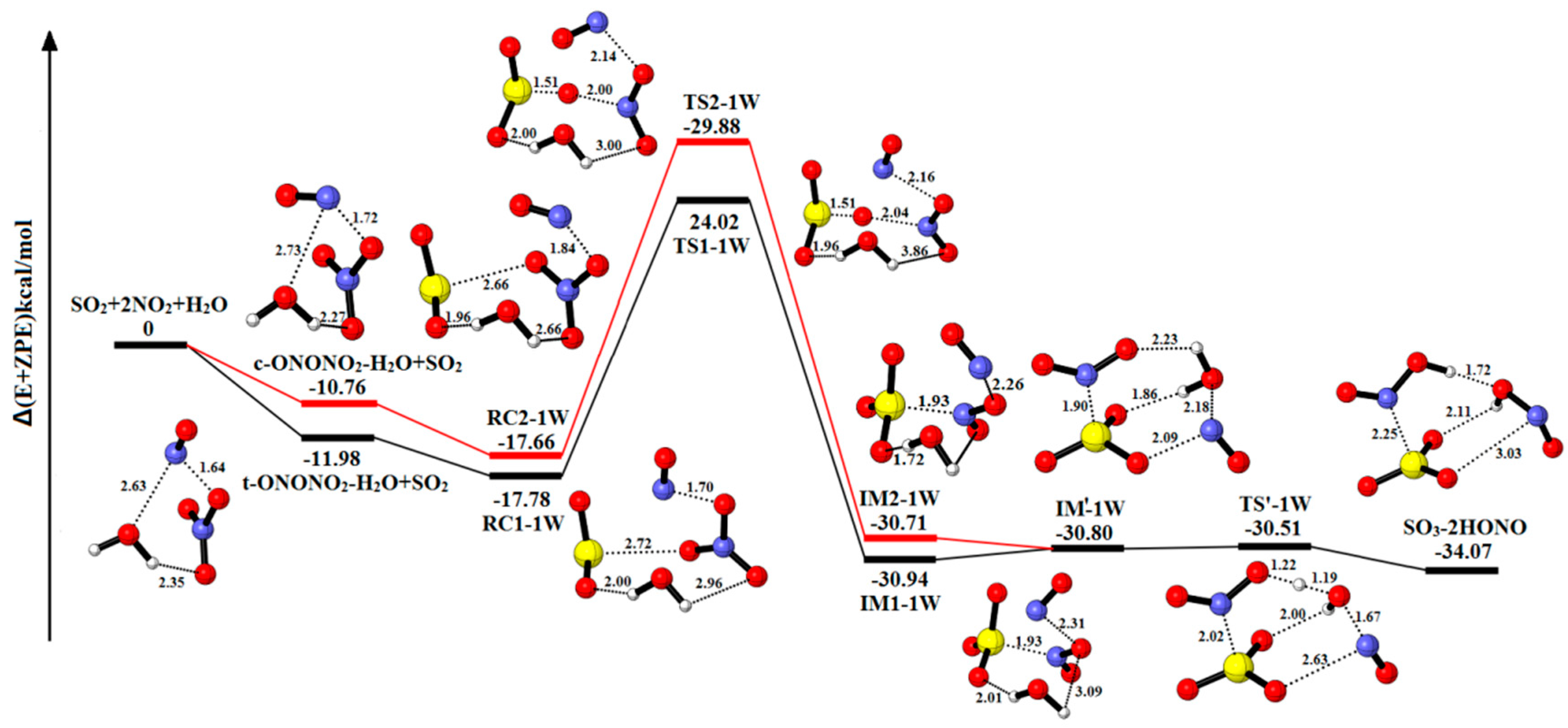
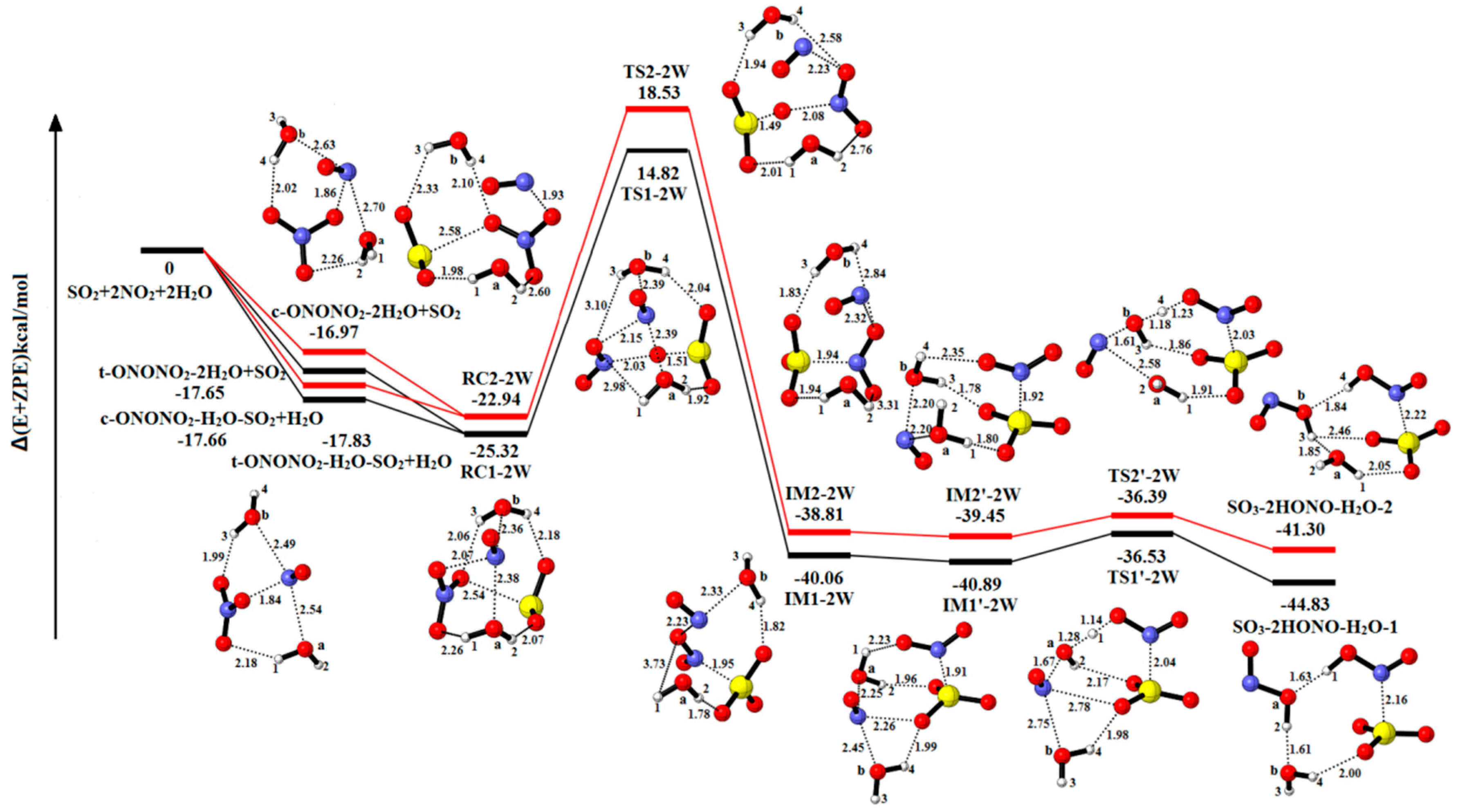
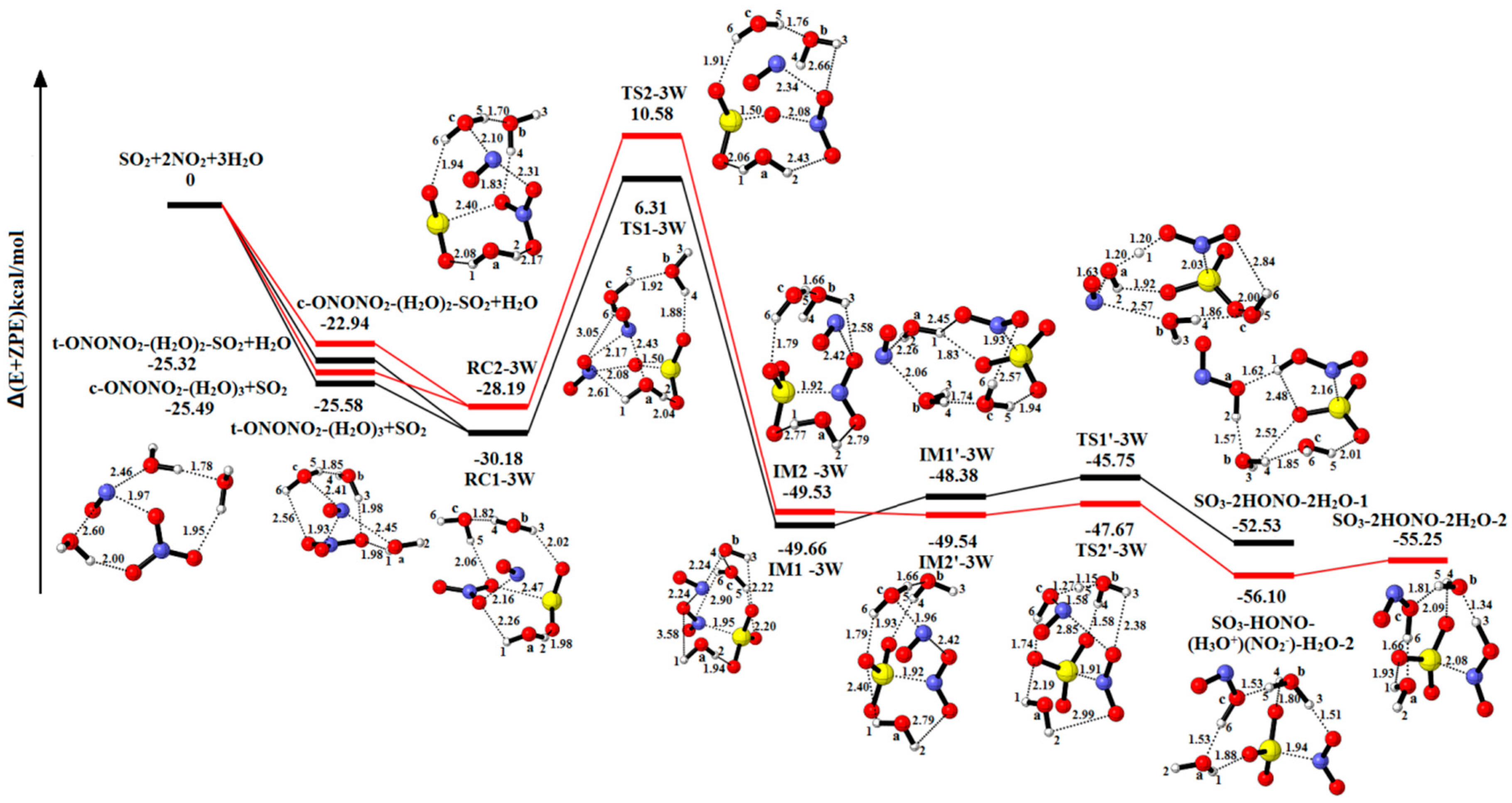
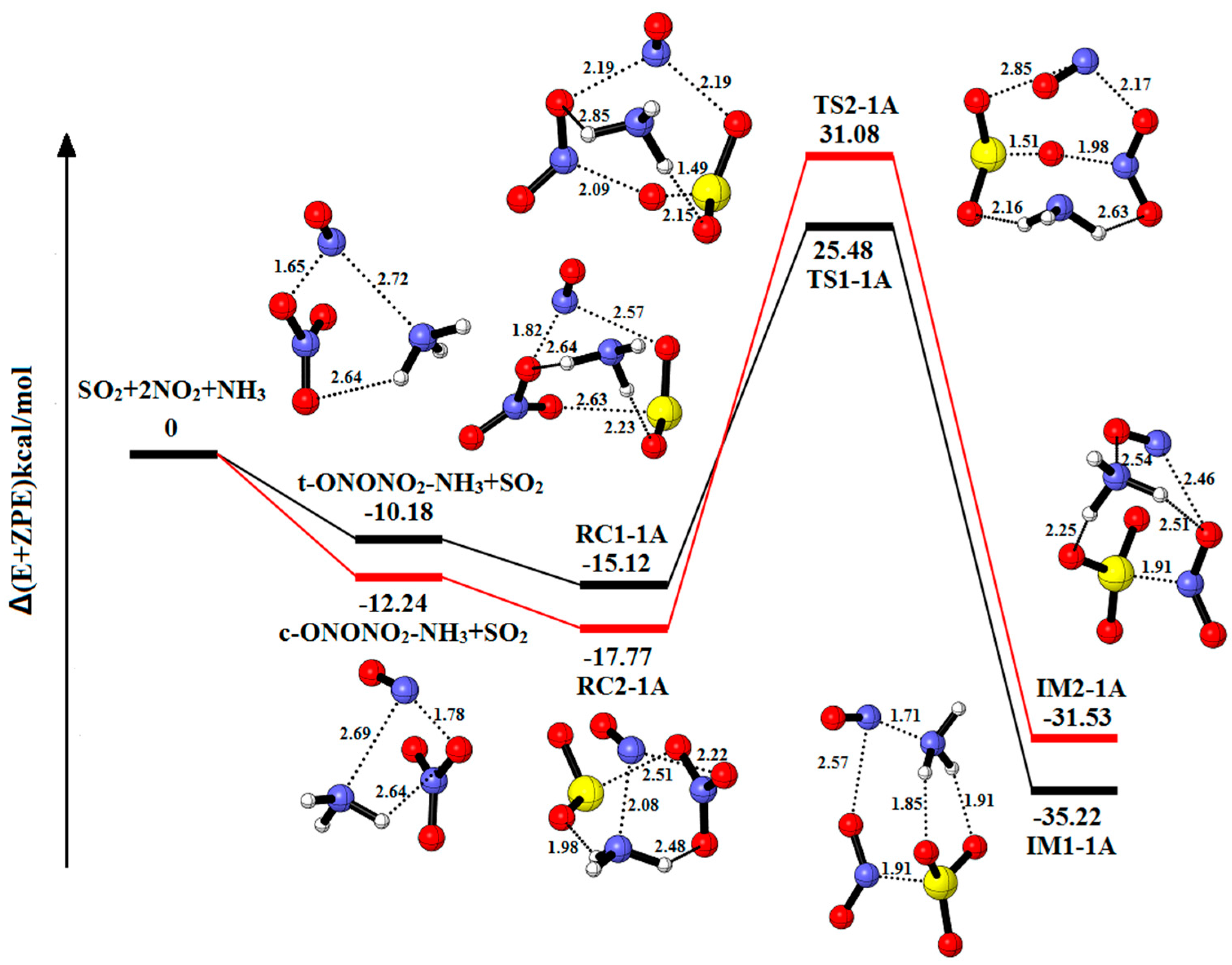
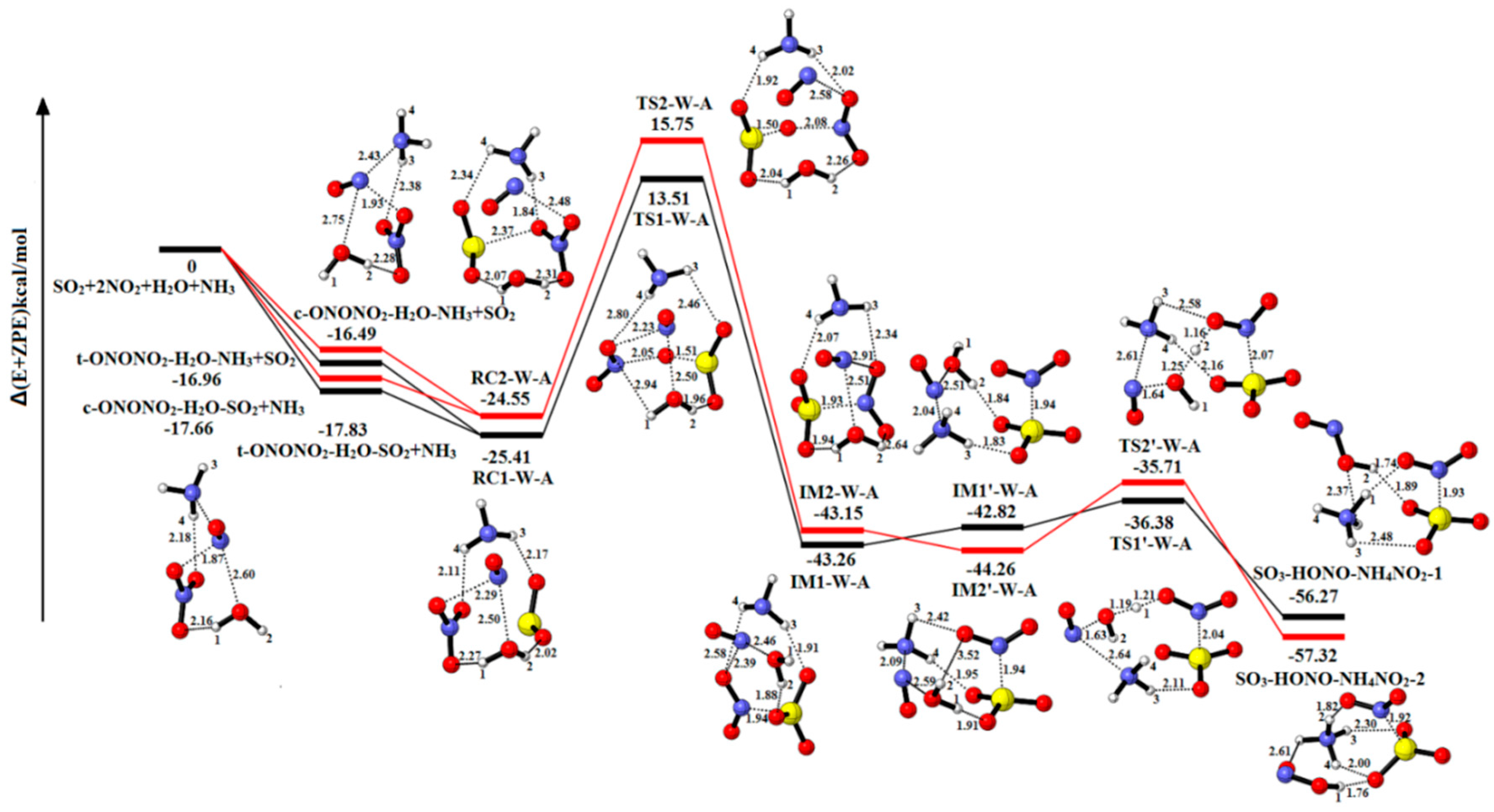
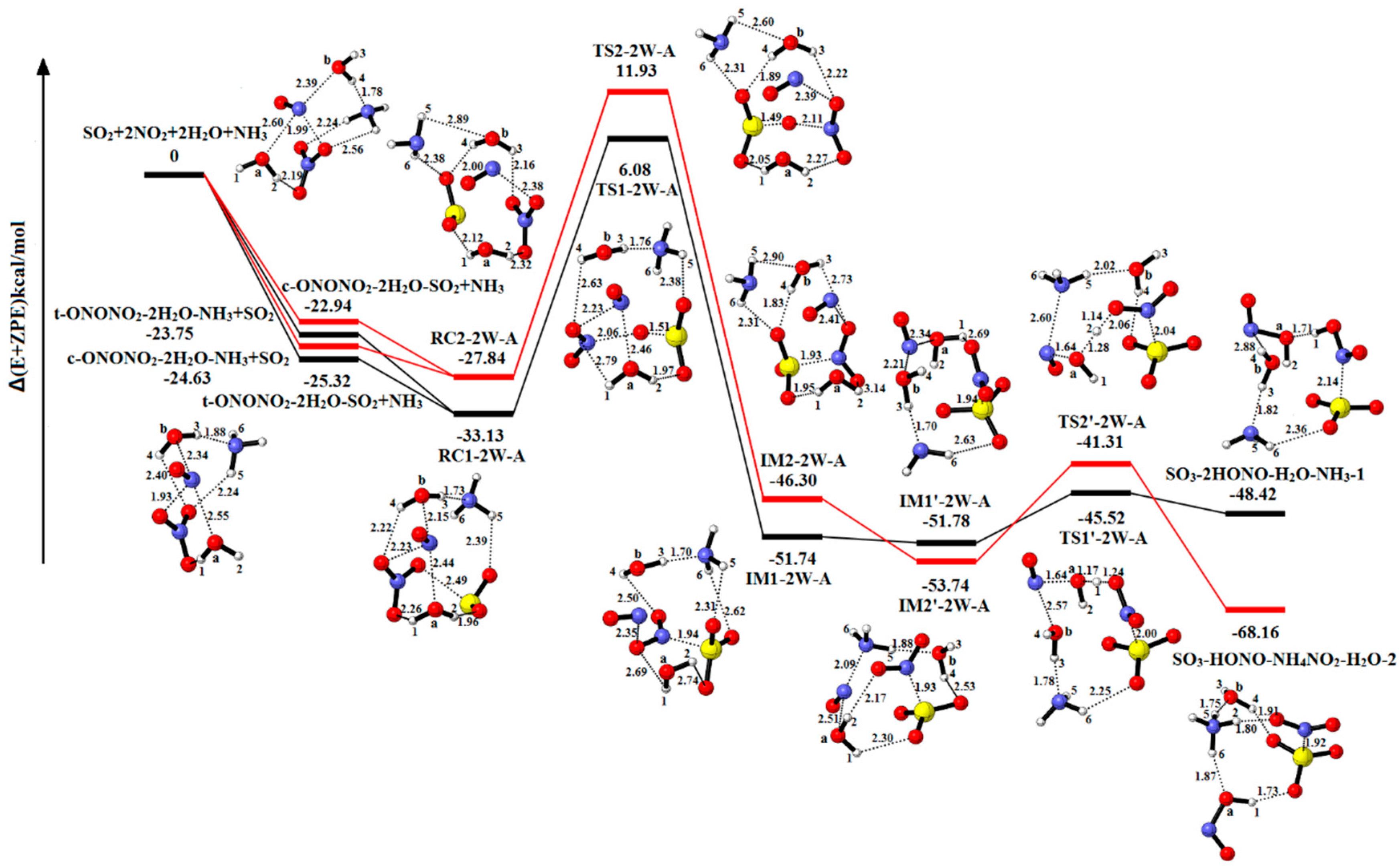
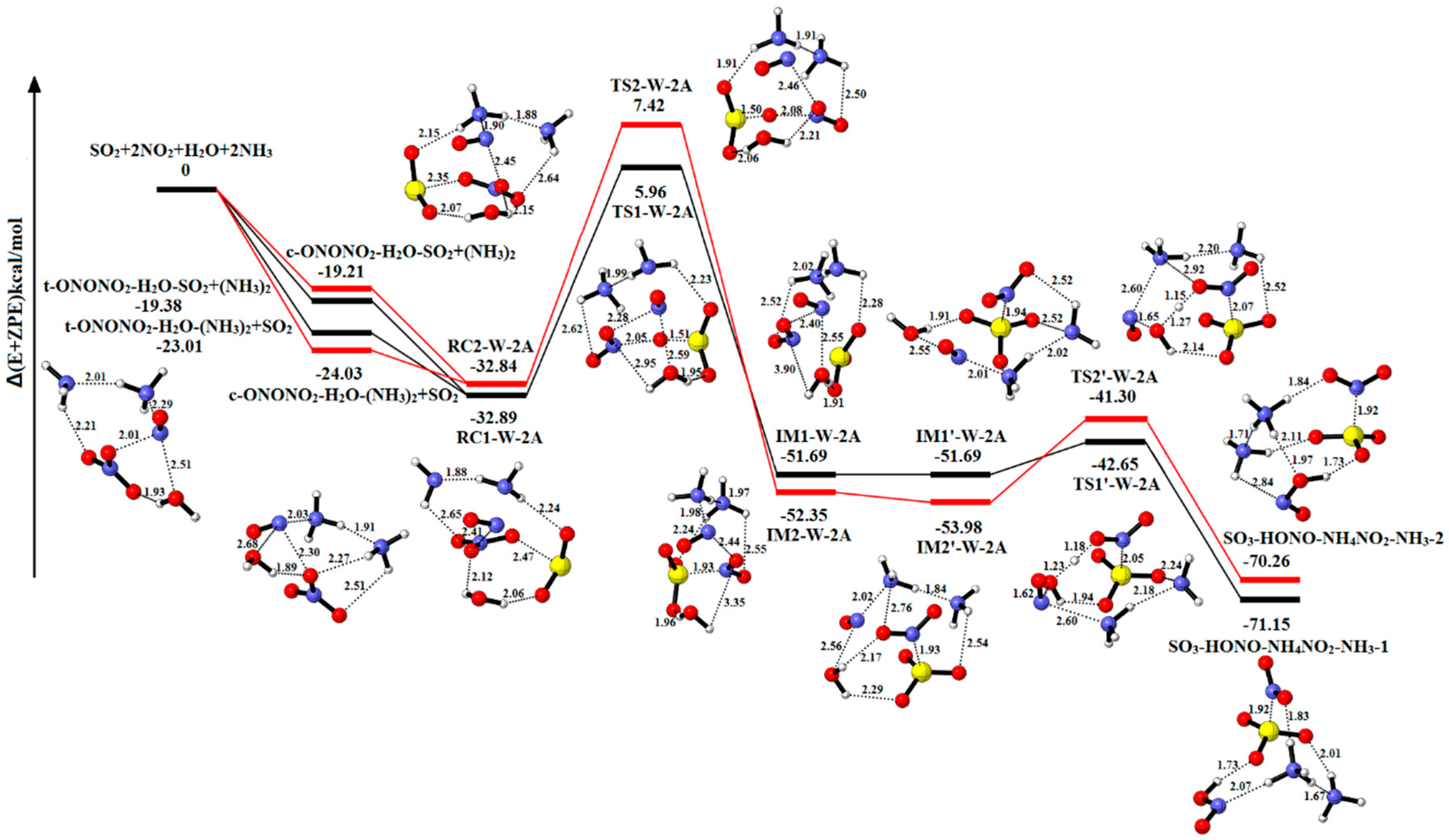
| Oxidation Reaction | Hydrolysis Reaction | |||
|---|---|---|---|---|
| Reaction Systems | Energy Barrier (kcal/mol) | Reaction Energy (kcal/mol) | Energy Barrier (kcal/mol) | Reaction Energy (kcal/mol) |
| SO2-2NO2 | 45.48 | −11.49 | ||
| 52.45 | −5.77 | |||
| SO2-2NO2-H2O | 41.80 | −13.16 | 0.29 | −3.27 |
| 47.54 | −13.05 | 0.29 | −3.27 | |
| SO2-2NO2-2H2O | 40.14 | −14.75 | 4.36 | −3.94 |
| 41.47 | −15.87 | 3.06 | −1.85 | |
| SO2-2NO2-3H2O | 36.49 | −19.48 | 2.63 | −4.15 |
| 38.77 | −21.34 | 1.87 | −6.56 | |
| SO2-2NO2-NH3 | 40.60 | −20.10 | ||
| 48.85 | −13.76 | |||
| SO2-2NO2-H2O-NH3 | 38.92 | −17.85 | 6.44 | −13.45 |
| 40.30 | −18.60 | 8.55 | −13.06 | |
| SO2-2NO2-2H2O-NH3 | 39.21 | −18.61 | 6.26 | 3.36 |
| 39.77 | −18.46 | 12.43 | −14.42 | |
| SO2-2NO2-H2O-2NH3 | 38.85 | −18.80 | 9.04 | −19.46 |
| 40.26 | −19.51 | 12.68 | −16.28 | |
| Reactant Complexes | NO+ | NO3− | Intermediate | NO+ | NO2− | |
|---|---|---|---|---|---|---|
| SO2-2NO2 | RC1 | 0.330 | −0.328 | IM1 | 0.502 | −0.201 |
| RC2 | 0.405 | −0.394 | IM2 | 0.501 | −0.217 | |
| SO2-2NO2-H2O | RC1-1W | 0.472 | −0.437 | IM1-1W | 0.712 | −0.250 |
| RC2-1W | 0.506 | −0.472 | IM2-1W | 0.688 | −0.280 | |
| SO2-2NO2-2H2O | RC1-2W | 0.644 | −0.605 | IM1-2W | 0.772 | −0.290 |
| RC2-2W | 0.592 | −0.532 | IM2-2W | 0.726 | −0.259 | |
| SO2-2NO2-3H2O | RC1-3W | 0.730 | −0.695 | IM1-3W | 0.767 | −0.309 |
| RC2-3W | 0.705 | −0.724 | IM2-3W | 0.621 | −0.282 | |
| SO2-2NO2-NH3 | RC1-1A | 0.448 | −0.442 | IM1-1A | 0.241 | −0.222 |
| RC2-1A | 0.458 | −0.635 | IM2-1A | 0.643 | −0.228 | |
| SO2-2NO2-H2O-NH3 | RC1-1W-1A | 0.599 | −0.569 | IM1-1W-1A | 0.640 | −0.261 |
| RC2-1W-1A | 0.508 | −0.672 | IM2-1W-1A | 0.596 | −0.279 | |
| SO2-2NO2-2H2O-NH3 | RC1-2W-1A | 0.675 | −0.673 | IM1-2W-1A | 0.773 | −0.296 |
| RC2-2W-1A | 0.722 | −0.625 | IM2-2W-1A | 0.717 | −0.241 | |
| SO2-2NO2-H2O-2NH3 | RC1-1W-2A | 0.440 | −0.696 | IM1-1W-2A | 0.549 | −0.297 |
| RC2-1W-2A | 0.449 | −0.691 | IM2-1W-2A | 0.488 | −0.283 |
© 2019 by the authors. Licensee MDPI, Basel, Switzerland. This article is an open access article distributed under the terms and conditions of the Creative Commons Attribution (CC BY) license (http://creativecommons.org/licenses/by/4.0/).
Share and Cite
Wang, Z.; Zhang, C.; Lv, G.; Sun, X.; Wang, N.; Li, Z. Synergistic Reaction of SO2 with NO2 in Presence of H2O and NH3: A Potential Source of Sulfate Aerosol. Int. J. Mol. Sci. 2019, 20, 3746. https://doi.org/10.3390/ijms20153746
Wang Z, Zhang C, Lv G, Sun X, Wang N, Li Z. Synergistic Reaction of SO2 with NO2 in Presence of H2O and NH3: A Potential Source of Sulfate Aerosol. International Journal of Molecular Sciences. 2019; 20(15):3746. https://doi.org/10.3390/ijms20153746
Chicago/Turabian StyleWang, Zehua, Chenxi Zhang, Guochun Lv, Xiaomin Sun, Ning Wang, and Zhiqiang Li. 2019. "Synergistic Reaction of SO2 with NO2 in Presence of H2O and NH3: A Potential Source of Sulfate Aerosol" International Journal of Molecular Sciences 20, no. 15: 3746. https://doi.org/10.3390/ijms20153746





